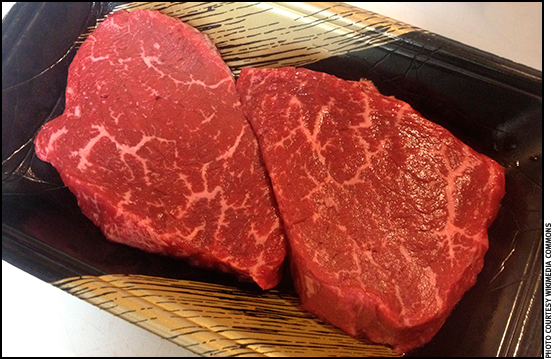MARKETING...

G × E Effects on Beef Quality
Research is investigating how genetics affect incidence of dark-cutting beef.
Is there a genetic component to the incidence of dark-cutting beef carcasses? U.S. Meat Animal Research Center Meat Scientist Steve Shackelford is wondering if dark-cutting beef is influenced by more than the environment.
Shackelford explained related research during the 2018 Beef Improvement Federation Convention hosted June 20-23 in Loveland, Colo. In a breakout session focused on end-product improvement, he suggested that some cattle may be genetically more susceptible to dark cutting.
To understand dark-cutting beef, it may be necessary to understand that the bright, cherry-red color associated with fresh beef results when beef muscle containing the “normal” amount of lactic acid is exposed to oxygen. Dark-cutting beef occurs among animals experiencing significant long-term stress, which depletes glycogen reserves in the animal’s body. It is glycogen that is converted to lactic acid postmortem. So, long-term stress depletes glycogen, which reduces postharvest lactic acid in muscle, and the result is dark-colored meat. Read more.
In the Cattle Markets
How 2018 market prices line up with the past.
Steer and heifer slaughter levels for the year to date have been slightly lower than forecasted, but up almost 2.3% over 2017. Slaughter will continue to have year-over-year increases, but the year-over-year increases will be smaller. September slaughter will likely be smaller than July. Live weights are up on average for 2018 almost 6 pounds (lb.). Beef production was previously anticipated to be up approximately 3.7%, but the year-to-date increase will be closer to 4%. First-quarter beef production was up 2.6% from 2017; whereas, second-quarter beef production was up just more than 5%. Read more.
Meet Your Beef
Group of 21 chefs and foodservice professionals tour cattle operations to learn more about beef.
The “Meat Your Beef” farm tour offered chefs and foodservice professionals the opportunity to do just that, to meet their beef. A group of 21 chefs from the suburbs of Philadelphia, Pa., attended a full-day beef tour in the south-central part of Pennsylvania June 26. The chef attendees source their beef from Indian Ridge Provisions, a further processor and distributor of proteins based in Telford, Pa.
The first tour stop of the day was the Masonic Village Farm located in Elizabethtown, Pa. Scotty Miller, beef herdsman at Masonic, led attendees through a firsthand look at the entire beef life cycle, from birth to market. Masonic Village Farm was selected as the 2016 National Beef Quality Assurance (BQA) Cow-Calf Award recipient, as well as the Region 1 Environmental Stewardship Award winner in 2011. Read more.
Risk Management for Cow-Calf Operators
CattleFax analyst shares tips for managing risk in cow-calf herds.
According to CattleFax Market Analyst Troy Applehans, there are a multitude of ways to manage risk, but few cow-calf producers use them. Applehans offered food for thought to cow-calf operators attending the 2018 Beef Improvement Federation Convention hosted June 20-23 in Loveland, Colo. He encouraged them to better manage risk by managing fixed costs, giving more thought to marketing, having a plan and being disciplined about carrying it out.
“The most basic thing, though, is knowing the breakeven price of your product,” stated Applehans, urging cattlemen to calculate their cost of production. “Knowing cow cost is imperative.” Read more.

Clint Mefford
The Source: Association announces
new AngusSource programs
Five PVP programs now available for commercial producers to enroll cattle.
The American Angus Association recently announced four additional USDA Process Verified Program (PVP) offerings through AngusSource®. This announcement goes hand-in-hand with the Association’s focus on providing comprehensive programs and services aimed at improving profitability in the commercial sector of the cattle industry.
AngusSource began in 2003, then transitioned to a PVP program in 2005 as the first age-and-source program for verifying Angus-sired calves in the industry. Now with the addition of four more PVPs to the AngusSource suite, commercial producers will have more opportunity to enroll their calves in the program, which helps them meet their marketing goals. Read more.
Latin American Product Showcase a Hit
Eighth annual USMEF Latin American Product Showcase brings record turnout of red-meat buyers to Dominican Republic.
The U.S. Meat Export Federation (USMEF) hosted its eighth annual Latin American Product Showcase June 27-28 in Santo Domingo, Dominican Republic. The event drew a record turnout of 190 buyers from 20 countries across the Caribbean, Central America and South America. On the exporter side, 54 USMEF member companies participated. The showcase was conducted with funding support from the National Pork Board (NPB), the Beef Checkoff Program, the Nebraska Beef Council, the Wisconsin Beef Council, the United Soybean Board and the Iowa Soybean Association. Read more.
May Beef Exports Shatter Value Record
Numbers don’t lie, global consumers want U.S. beef.
U.S. beef exports set a new value record in May while also increasing significantly year-over-year in volume, according to data released by USDA and compiled by the U.S. Meat Export Federation (USMEF). May pork exports were lower than a year ago, though January-May totals for U.S. pork remained ahead of last year’s pace.
Beef export volume was 117,871 metric tons (mt) in May, the sixth-largest on record, valued at a remarkable $722.1 million, which surpassed the previous monthly high (March 2018) by a healthy 4% and was 24% higher than a year ago. Through the first five months of 2018, beef exports were up 10% in volume to 547,157 mt while export value was $3.32 billion, 21% above last year’s record pace. Read more.






